Services on Demand
Article
Indicators
Related links
-
 Cited by Google
Cited by Google -
 Similars in Google
Similars in Google
Share
Journal of the Southern African Institute of Mining and Metallurgy
On-line version ISSN 2411-9717
Print version ISSN 2225-6253
J. S. Afr. Inst. Min. Metall. vol.115 n.7 Johannesburg Jul. 2015
http://dx.doi.org/10.17159/2411-9717/2015/V115N7A6
GENERAL PAPERS AND TECHNICAL NOTE
Support stability mechanism in a coal face with large angles in both strike and dip
L.Q. MaI, II; Y. ZhangI, II; D.S. ZhangI, II; X.Q. CaoI, II; Q.Q. LiI, II; Y.B. ZhangIII
ISchool of Mines, China University of Mining & Technology, Xuzhou, China
IIKey Laboratory of Deep Coal Resource Mining, Ministry of Education of China, Xuzhou, China
IIIState Development & Investment Corporation Xinji Energy Company Limited, Huainan, China
SYNOPSIS
To solve the support stability control problem for a coal face with large angles along both strike and dip (CLSD), the 'support-surrounding rock' mechanical model has been developed, which takes into account the impact of the dip angle of the seam on the stability of the support in the strike direction. The mechanical relationships of the critical topple angle and critical slip angle of the support along the strike of the coal face with large dip angle and the support height, support resistance, friction coefficient, and other factors have been derived through the mechanical analysis of support stability in the strike direction of CLSDs in the free state, the operating state, and the special state. The research findings were applied to a fully mechanized CLSD in Xinji Coal Mine. The maximum underhand angle and overhand angle in strike are 42° and 25° respectively, and the maximum dip is 39°. It is calculated that during underhand mining and overhand mining, the critical support resistances for avoiding support toppling are 3723 kN and 1714 kN respectively, and the critical support resistances for avoiding slipping of the support are 7405 kN and 6606 kN respectively. Thus, the selection of type ZZ7600/18/38 hydraulic roof support for the coal face is justified. Measures to prevent sliding of the support and the installation of a limiting stop maintain the support runs in good condition and ensure safe and efficient mining of CLSD.
Keywords: coal mining, support stability, dip angle, strike angle, critical topple, critical slip
Introduction
A coal seam with a large dip angle (CLDA) is a seam that dips at 35°-55°. CLDAs account for about 15-20% of China's coal reserves and 5-10% of the output. More than 50% of the coal seams comprise scarce coal varieties under protective mining. CLDA mining is challenging due to the difficulty in controlling the stability of the roof, floor, and the coal face equipment, the difficult operating environment for workers, frequent accidents, and low extraction rates. CLSD refers to a coal face having a large underhand angle or large overhand angle in the strike direction, as well as a large dip angle. To ensure safe production at the coal face, more stringent requirements for the stability of the support and other equipment, as well as roof control, have been proposed.
The mining of CLDA occurs mainly in the region of the former Soviet Union, and relevant reports are also available from Germany, France, Spain, and India. The study of CLDA mining includes the mining method, strata control, and equipment development. In recent years, the study of CLDA mining has focused mainly on surface subsidence and its prediction. Kulakov (1995a and 1995b) made a systematic study of the rock pressure in a coal face with steep dip (large dip angle). Rafael and Javier (2000) investigated subsidence phenomena caused by CLDA mining and established a subsidence prediction model for CLDA mining.
Chinese scholars have focused on the support stability control mechanism in a coal face with large dip angle. Wu (2006, 2005) analysed the varieties of instability of a roof-support-floor (R-S-F) system under diverse conditions, established a R-S-F system dynamic model, and determined the control mode for R-S-F system dynamic stability. Lin et al. (2004) analysed anti-topple, anti-slip, and skew stability of hydraulic support for fully mechanized caving mining under the condition of large dip angle based on statics. Combined with field investigations, they studied three kinds of stability of hydraulic support for fully mechanized caving mining with large dip angles.
However, all the research findings to date that analyse the support stability start from the point of view of the coal face dip angle. The research involving underhand/overhand mining has also focused merely on the characteristic analysis of roof-breaking (Zhang et al., 2010; Tian et al., 1994). There are few reports in the literature on research into support stability for CLSD.
The current investigation examines the underhand and overhand mining of CLSD at State Development & Investment Corporation's Xinji Coal Mine, in the Anhui Province of China. The impact of the dip angle of the coal seam on support stability in the strike direction is considered for the first time, based on the actual conditions for underhand mining and overhand mining. The dip angle is introduced as an important parameter in the 'support-surrounding rock' mechanical model to study the instability of the support in the strike direction. Mechanical parameters of the support in the free state, the operating state, and the special state are calculated for underhand mining and overhand mining. The factors that impact on support stability in the strike direction are analysed, and methods are proposed to solve the stability control problem in CLSD.
CLSD 'support-surrounding rock' mechanical model
Support stability in the strike direction in the free state
Support stability depends on the interaction between the angle of strike and dip angle of the coal face. The analysis of deadweight of the support is shown in Figure 1 (Cao et al., 2010; Ma et al., 2010; Zhang, 2010; Li, 2009; Ostayen et al., 2004).

Underhand mining stage
The mechanical model of the support in the free state is shown in Figure 2.

The topple mechanical model of the support in the free state is shown in Figure 2(a), and its stress state is given by:

where G2 =G cos α cos β1,
The critical topple angle β1 is:

where G is the support deadweight (kN), G2 is the component of the support deadweight perpendicular to the floor (kN), G3 is the component force of the gravity of support along the strike direction of the coal face (kN), α is the dip angle of the coal face, L is the base length of the support (m), h is the support height (m), λ1 is the height coefficient of the gravitational centre of the support (the ratio between the height of gravitational centre y and the support height h), and λ2 is the length coefficient of the gravitational centre of the support (the ratio between the tail length of the support base away from the gravitational centre x and the base length of the support L).
The slip mechanical model of the support in the free state is shown in Figure 2 (b), and its stress state is analysed in Equation [3]:

The critical slip angle β2 is:

where ƒ21 is the frictional resistance provided by the floor to the support (kN), R21 is the reaction force between the floor and the support (kN), and μ is the frictional coefficient between the support and the roof/floor.
Overhand mining stage
The mechanical model of the support in the free state is shown in Figure 3.

The topple mechanical model of the support in the free state is shown in Figure 3 (a) and its stress state is analysed in Equation [5]:

The critical topple angle β1 s shown by Equation [6]:

The slip mechanical model of the support in the free state is shown in Figure 3 (b), and its stress state is analysed in Equation [7]:

The critical slip angle β2 is given by Equation [8]:

Support stability in the strike direction in the operating state
Underhand mining stage
The mechanical model of the support in the operating state is shown in Figure 4.

The topple mechanical model of the support in the operating state is shown in Figure 4 (a), and its stress state is analysed in Equation [9]:
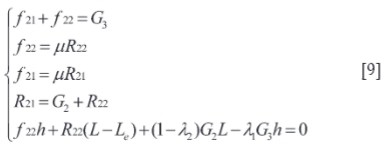
where f22is the frictional resistance provided to the roof by the support (kN), Le is the distance between the tail of the support canopy and the tail of the support base (m), and R22 is the reaction force between the roof and the support (kN).
The critical topple angle β1 is given by:

where M1= LR22+ R22μh - R22Le
The slip mechanical model of the support in the operating state is shown in Figure 4 (b) and its stress state is analysed in Equation [11]:
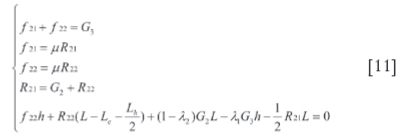
The critical slip angle β2 is given by:

Overhand mining stage
The mechanical model of the support in the operating state is shown in Figure 5.

The topple mechanical model of the support in the operating state is shown in Figure 5 (a) and its stress state is analysed in Equation [13]:
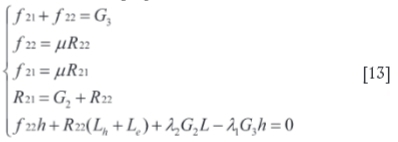
The critical topple angle β1 is given by:

The slip mechanical model of the support in the operating state is shown in Figure 5 (b) and its stress state is analysed in Equation [15]:
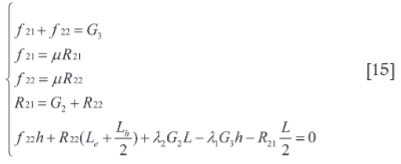
The critical slip angle β2 is given by:

Support stability in the strike direction in the special state
The stress state of the support in the strike direction for the coal face in the special state is shown in Figure 6. When roof weighting occurs in the coal face, the support stability is subjected to a larger lateral force, due to roof fracture, which is generated in the upper part of the support along the strike direction. The impacts of faulting, roof falls, and other factors on the support are consistent with that of roof weighting in the coal face in the strike direction.

The caving zone
After the coal has been extracted, the roof strata will fail from bottom to top, layer by layer. When a stable geometry is formed in the strata above the caving zone, the lateral force on the support is mainly from the weight of the rock within the caving zone (Qian and Miao, 1995).
The theoretical thickness of strata in the caving zone, hK (m), is shown in Equation [17]:

where M is the mining height (m), KK is the bulking factor, and α is the dip angle of the coal face.
The thickness of each layer of the immediate roof and the main roof is accumulated from bottom to top to evaluate hK.
When hK is reached or exceeded, the last layer will be the top layer in the caving zone. The total thickness from the bottom layer to the top layer is the actual thickness of strata in the caving zone, as shown in Figure 7 (Dou et al., 2009).

The total weight of the rock in the caving zone P (kN) is given by:

where
b is the support width (centre to centre) (m)
Yz is the average body force of the immediate roof in the caving zone (kN/m3)
hz is the thickness of the immediate roof (m)
Lz is the rock canopy length of the immediate roof (m).
Lz=Ld+Lh+Lzx (Ld is the tip-to-face distance, which is
about 1.0 m, Lh is the sum of the support canopy and
front canopy lengths (m), Lzx is the maximum hanging
length of the immediate roof behind the support (for the
mudstone, Lzx is about 1.0 m)
n is the number of the main roof layers in the caving zone
Yiis the average body force of the ith layer of the main roof in the caving zone (kN/m3)
hi is the thickness of the ith layer of upper roof in the caving zone (m)
Li is the length of the ith layer of rock in the main roof in the caving zone.
The actual measured data for rock length of each main roof should be used for the calculation. If there is no actual data, the rock length of each main roof can be assumed to be the same as the rock length of the first layer of the main roof, due to few main roof layers collapsed in the actual caving zone. The rock length of the first layer of the main roof is the average periodic weighting interval at the coal face (m).
The lateral force on the support from the rock in the caving zone F1 (kN) is shown in Equation [19].

Underhand mining stage
The mechanical model of the support in the special state is shown in Figure 8.

The topple mechanical model of the support in the special state is shown in Figure 8 (a) and its stress state is analysed in Equation [20]:

The critical topple angle β1 is given by:

The slip mechanical model of the support in the special state is shown in Figure 8 (b) and its stress state is analysed in Equation [22]:
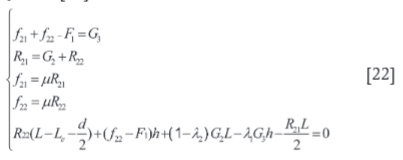
The critical slip angle β2is given by:

Overhand mining stage
The mechanical model of the support in the special state is shown in Figure 9.

The topple mechanical model of the support in the special state is shown in Figure 9 (a) and its stress state is analysed in Equation [24]:
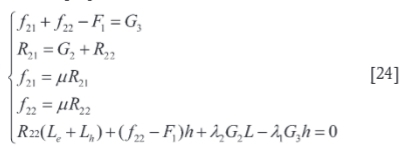
The critical topple angle β1 is given by:

where 
The slip mechanical model of the support in the special state is shown in Figure 9 (b) and its stress state is analysed in Equation [26]:
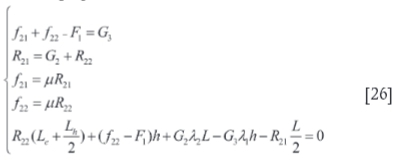
The critical slip angle β2 is given by:

Increasing the support resistance, increasing the frictional coefficient between the support and the roof/floor, and reducing the support deadweight (while ensuring the support has sufficient strength) can be conducive to preventing the support from slipping in the strike direction.
Engineering projects
Mining geological conditions
In Xinji Coal Mine, the E1108 coal face has a length of 877 m in the strike direction and 115 m in the dip direction. The thickness of the seam is 2.2-3.6 m, with an average thickness of 2.83 m. The conditions in the roof of the seam are shown in Table I. The dip angle of the coal seam is 22-39°, with an average of 30°. Because the strike direction of the coal seam at the coal face varies, underhand mining is adopted in the inner segment of the coal face, and overhand mining in the outer segment. The dip angle of the seam in the underhand mining section is 22-35° and the maximum underhand mining angle is 42°. The dip angle of the seam in the overhand mining section is 28-39° and the maximum overhand mining angle is 25°. The layout and the cross-section of the E1108 coal face are shown in Figure 10. ZZ7600/18/38 chock-shield support is utilized for the coal face. At the mining height of 2.8 m, the height coefficient and the length coefficient of the gravitational centre of the support are 0.5 and 0.4 respectively. The distance between the tail of the support canopy and the tail of the support base is 0.95 m. The main technical parameters of the support are shown in Table II.
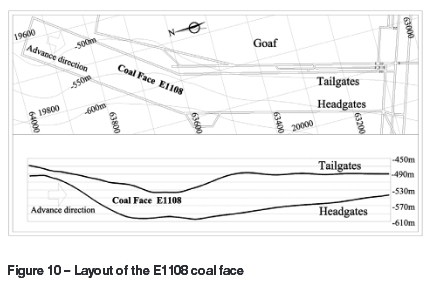
Back-analysis of the support selection
The friction coefficient is considered to be 0.3 (Hu et al., 2008) and technical parameters of the support are put into the mechanical model in the free state. The critical topple angle and the critical slip angle of the support for the coal face in the free state can be calculated for the maximum dip angle, which is 35° during underhand mining and 39° during overhand mining. The results are shown in Table III.

If the working resistance of the support (7600 kN) and the maximum dip angle of the coal face are entered into Equations [10], [12], [14], and [16], neither the critical topple angle nor the critical slip angle of the support in the operating state are reached at the stage of underhand mining or overhand mining.
If the maximum dip angles of 35° during underhand mining and 39° during overhand mining are entered into Equation [17], the corresponding thicknesses of the theoretical caving zone are 8.54 m and 9 m. The immediate roof and the first layer of the main roof slice can completely fill the gob area. Therefore, the highest slices of the caving zone during underhand mining and overhand mining are both the first layer of the main roof slice. If the parameters are entered into Equation [18], the total weight of the rock in the caving zone, P, can be calculated as 5410 kN.
If the working resistance of the support is 7600 kN, and P and the maximum dip angle of the coal face during underhand mining and overhand mining are entered into Equations [21], [23], [25], and [27], the critical topple angle and the critical slip angle of the support in the special state can be obtained for underhand mining and overhand mining. The results are shown in Table IV.
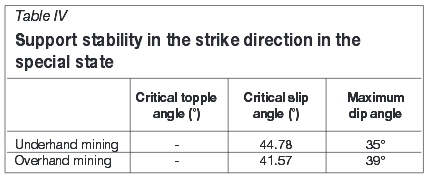
The critical support resistance at the maximum underhand mining angle and maximum overhand mining angle of the coal face in the special state can be calculated using Equations [21], [23], [25], and [27]. The results are shown in Table V.
It can be seen from the results that the working resistance of the support meets the requirements not only in the operating state, but also in the special state. During underhand mining and overhand mining at large angles, the support is prone to slip and topple in the free state, and this is much more likely to occur during overhand mining than during underhand mining. Therefore, some auxiliary measures are required in order to ensure support stability in the free state.
Auxiliary measures
Prevention of sliding of the support
It can be seen from mechanical analysis that the support can easily slip in the free state. Therefore, measures must be introduced to increase the frictional force between the support base and the floor and between the support canopy and the roof at all times, thus changing the support action from the free state into the operating state.
Installation of the limiting stop
In order to prevent the sliding of the scraper conveyor and the swinging of the support during support advance, limiting stops are installed on the support base (see Figure 11) to restrict the swing range of the push-pull rod and to ensure support stability.
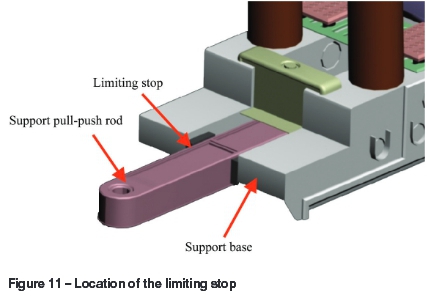
Practical effect
During underhand mining at a large angle, the support has a maximum support resistance of 7489 kN, reaching 98.5% of the working resistance; and the average support resistance during roof weighting is 4354 kN, and 3175 kN without roof weighting.
During overhand mining at a large angle, the support has a maximum support resistance of 6535 kN, reaching 86.0% of the working resistance; and the average support resistance during roof weighting is 3461 kN, and 2676 kN without roof weighting.
It can be seen that the support resistance meets the requirements for roof control. Assisted by technical enhancements, including anti-topple and anti-slip measures, the support provides good operating conditions, and ensures normal mining of CLSD. The daily average coal cutting production is 2080 t. The operating states of the support for the coal face during underhand mining are shown in Figure 12, and during overhand mining in Figure 13.
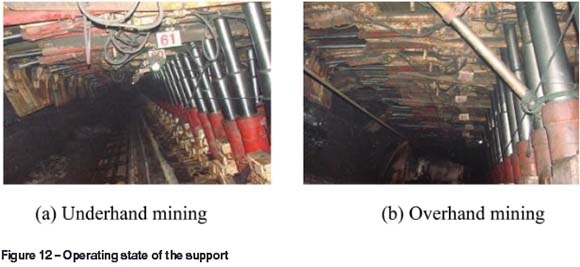
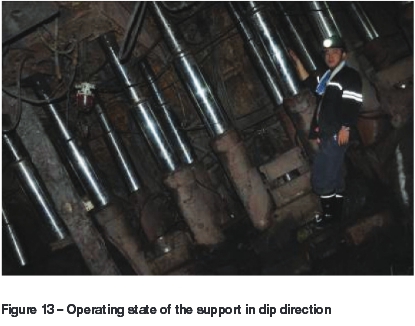
Discussion
According to the mechanical model, by reducing the height of the gravitational centre of the support, reducing the weight of the support, increasing the base length of the support, and increasing the support's resistance, the anti-topple and anti-slip capacity of the support can be significantly improved. Therefore, in the support design, the established mechanical model can be adjusted to optimize the structure of the support and the dimensions of each part of the support, so as to enable it to be best suited for CLSD and to have a strong anti-topple and anti-slip capacity. This mechanical model is applicable not only to support selection for Xinji Coal Mine's E1108 coal face, but also to other CLSD situations.
The established mechanical model described above does not cater for some special cases yet. For example, during underhand mining at a large angle, the waste within the gob area may surge onto the support, causing a thrust on the support, and increasing the possibility of slipping and toppling.
The limiting stops installed on the support restrict the swing range of the push-pull rod. As the push-pull rod is rigidly connected, it may break when the sliding impulsive force of the scraper conveyor is very large. To avoid this, a hydraulic jack can substitute for the limiting stop, with a safety valve installed to ensure the normal use of the push-pull rod.
Key conclusions
➤ The 'support-surrounding rock' mechanical model has been developed considering the impact of the dip angle of the coal seam on the support stability in the strike direction. The mechanical analysis of the support is divided into the free state, the operating state, and the special state. Various forces have been adopted as the boundary conditions, so as to obtain the critical topple angle and the critical slip angle of the support in different states. The key factors that impact on the support stability of the coal face with a large dip angle have been analysed
➤ The research findings have been applied to the E1108 fully mechanized coal face in Xinji Coal Mine, and the critical support resistances required to ensure that the support neither topples nor slips during underhand and overhand mining have been calculated. It has been verified that the working resistance of the support meets requirements for support in the special state
➤ During underhand mining and overhand mining of the E1108 coal face with a large angle, the resistance of the support meets the requirements for roof control and the selection of the coal face support is relatively reasonable. Assisted by technical enhancements, such as prevention of sliding of the support and the installation of a limiting stop, the support has achieved good operating conditions, and ensured normal mining of CLSD.
Acknowledgements
We thank State Development & Investment Corporation Xinji Energy Company Limited for their assistance. We also thank Dr. F.T. Wang and the Fundamental Research Funds for the Central Universities (2014YC01). This work was supported by Qing Lan Project, and the Priority Academic Program Development of Jiangsu Higher Education Institution.
References
Cao, S.G., Xu, J., Lei C.G., Peng, Y., and Liu, H.L. 2010. The stent adaptability of steep fully mechanized working face under the complex conditions. Journal of China Coal Society, vol. 35, no. 10. pp. 1599-1603 (in Chinese). [ Links ]
Dou, L.M., Lu, C.P., and Mou, Z.L. 2009. The stope roof control and monitoring technology. China University of Mining and Technology Press, Xuzhou (in Chinese). [ Links ]
Hu, M. and Cao, B.D. 2008. Analysis for lateral stability of ZY10800/28/63 powered support. Coal Mine Machinery, vol. 29, no. 8. pp. 61-63 (in Chinese). [ Links ]
Kulakov, V.N. 1995a. Stress state in the face region of a steep coal bed. Journal of Mining Science, vol. 31, no. 3. pp. 161-168. [ Links ]
Kulakov, V.N. 1995b. Geomechanical conditions of mining steep coal beds. Journal of Mining Science, vol. 31, no. 2. pp. 136-143. [ Links ]
LI, H.C. 2009. Force analysis of hydraulic support. Coal Mine Machinery, vol. 30, no. 7. pp. 69-71 (in Chinese). [ Links ]
Lin, Z.M., Chen, Z.H., Xie, J.W., and Xie, H.P. 2004. Stability analysis and control measures of powered supports in greater inclined full mechanized coal seam. Journal of China Coal Society, vol. 29, no. 3. pp. 264-268 (in Chinese). [ Links ]
Ma, L.Q., Zhang, D.S., Ren, T.X., Zhang C.G., and Li, Y.S. 2010. Support design and strata control of coal face with deep dip angle and large mining height. ICMHPC-2010 International Conference on Mine Hazards Prevention and Control, Qingdao, China, 15-17 October 2010. Atlantis Press, Paris, France. pp. 460-467. [ Links ]
Ostayen, R.A.J.V., Beek, A.V., and Ros, M. 2004. A parametric study of the hydro-support. Tribology International, vol. 37, no. 8. pp. 617-625. [ Links ]
Qian, M.G. and Miao, X.X. 1995. Theoretical analysis on the structural from and stability of overlying strata in longwall mining. Chinese. Journal of Rock Mechanics and Engineering, vol. 14, no. 2. pp. 97-106 (in Chinese). [ Links ]
Rafael, R.D. and Javier, T.A. 2000. Hypothesis of the multiple subsidence trough related to very steep and vertical coal seams and its prediction through profile functions. Geotechnical and Geological Engineering, vol. 18, no. 4. pp. 289-311. [ Links ]
Tian, Q.Z., Liu, J.C., and Zhang, Y.Q. 1994. Fracturing characteristics of main roof strata when mining uphill and downhill and its effect on stability of immediate roof. Journal of China Coal Society, vol. 19, no. 2. pp. 140-150 (in Chinese). [ Links ]
Wu, Y.P. 2006. Keys to dynamic equations of system R-S-F and determination on working resistance of face support in steeply dipping seam mining. Journal of China Coal Society, vol. 31, no. 6. pp. 736-741 (in Chinese). [ Links ]
Wu, Y.P. 2005. Dynamic equation of system 'roof (R)-support (S)-floor (F)' in steeply dipping seam mining. Journal of China Coal Society, vol. 30, no. 6. pp. 685-689 (in Chinese). [ Links ]
Zhang, Y.D., Cheng, J.Y., Wang, X.X., Feng, Z.J., and Ji, M. 2010. Thin plate model analysis on roof break of up-dip or down-dip mining stope. Journal of Mining and Safety Engineering, vol. 27, no. 4. pp. 487-493 (in Chinese). [ Links ]
Zhang, W.D. 2010. Research on the stability of hydraulic support with the large mining height under conditions of the big inclination and the large depression angle. Mining and Processing Equipment, vol. 38, no. 1. pp. 21-24 (in Chinese). [ Links ]
Received June 2012
Revised paper received May 2015














